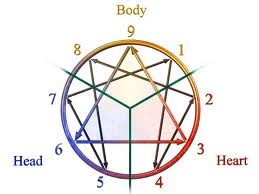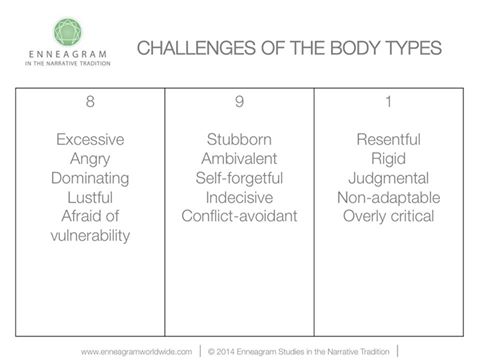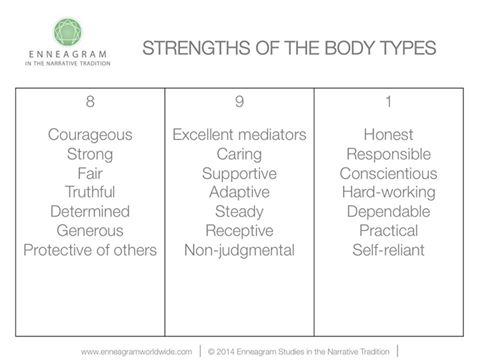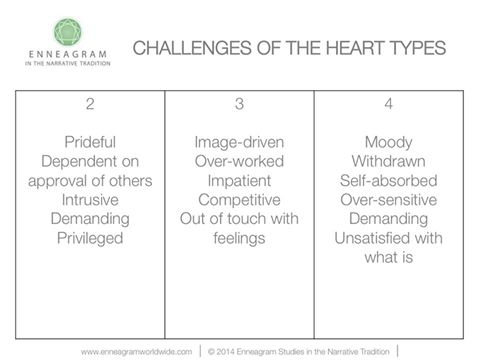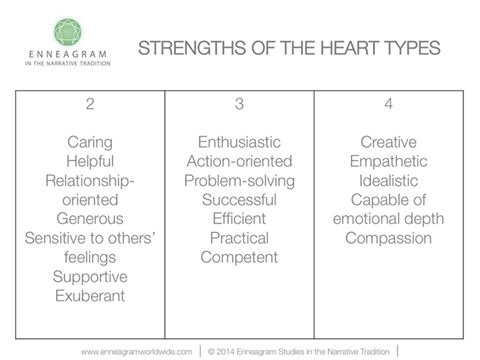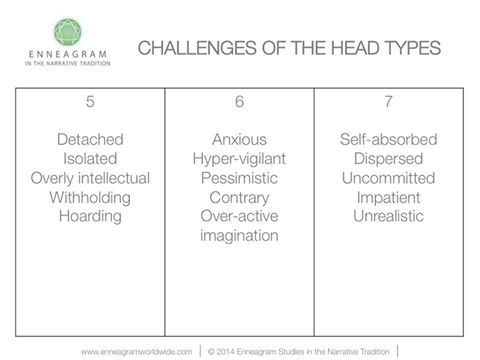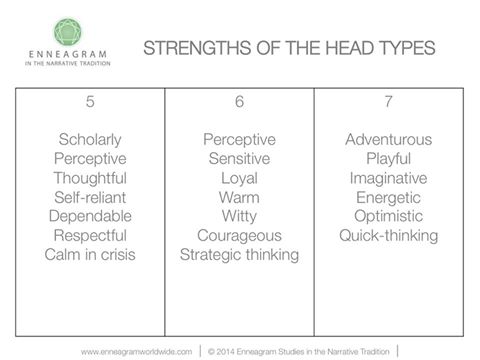The nine Enneagram types are grouped into three centres: Body (Instinctive/Gut/Belly), Heart (Feeling), and Head (Thinking), with three Enneagram types in each centre. Body centre contains types 8, 9 and 1 are formed as a response to anger. Heart centre contains types 2, 3 and 4 are formed as a response to shame, and create a self-image. Head centre contains types 5, 6 and 7 are formed as a response to fear or anxiety.
Values of Integrating Three Centres
No matter what Enneagram type we are, we have all the three centres in us, and they interact with each other, we cannot work on one centre without affecting the other two. In fact, the centre that our Enneagram type resides, it is the psyche that we are least able to function freely because its function has been blocked or distorted by our ego. For example, Enneagram type 9 is in the body centre, but it is the Enneagram type that is most disengaged with their body, not physically but internally-falling asleep to one’s vitality.
Knowing which centre we are operating is an important first step toward self-awareness. And the next step we need to do is integrating all the three centres within ourselves so that we can lead a more balanced and satisfying life, and consequently build more fulfilling relationships with people around us.
Three Centres Meditation by Peter O’Hanrahan
Peter O’Hanrahan leads a meditation exploring the three centers of attention at a Leadership Conference. This meditation heightens awareness of one’s inner reality and how to harness these Centers in leadership.
The Body (Instinctive ) Centre
Types 8, 9, and 1 have distortions in their instincts, the root of our life-force, vitality and survival. The body centre is concerned with the intelligence of the body, being in the body is direct experience of our existence. This being is a sense of being alive, being connected, being one with things. When we are not present, we lose the sense of confidence, fullness, and existing.
The common emotion for body centre is anger. The anger comes from the instinctual response to the sense of feeling interfere or mess with. Our unconscious fear of unity is that we will lose ourselves, our sense of functioning and intactness. The body centre types want autonomy and are concerned with control of the environment.
Type 8s tend to act out their anger, they express their anger very easily and rapidly. They put their guard up, so that no one can get through their defences and hurt them. Their anger commonly arises from situations where they or someone else experiences injustice.
Type 9s are the most out of touch with their anger, they tend to disconnect from their anger and build harmony and comfort both internally and externally. They turn a blind eye to whatever threatens their peace. Their anger can be referred to as “the anger that went to sleep”.
Type 1s tend to repress and internalised their anger. They do not like to express their anger externally, and can be very self‐critical and working very hard to hold back their unconscious impulses.
To conclude, type 8s externalised and act out their anger, type 9s feel conflicted and disconnect with their anger, and type 1s internalised and repress their anger.
Types 2, 3 and 4 have distortions in their feelings. The heart knows the truth, it let us know the truth of who we really are, our identity. It is also where we can feel a sense of meaning, value, and glory of our existence. When someone says something that is really resonating and true, our heart opens up, we feel deeply connected. So being in touch with our heart tells us the quality of our existence, tell us how we know the truth.
The common emotion for the heart centre is shame. Types 2, 3, and 4 are looking for mirroring, recognition, and validation. We need this because when we are a little baby we don’t have the capacity of self-reflection. We can only figure out who we are through others’ eyes. So when we don’t get the attention we want, we feel a deep sense of deficiency, shame and emptiness. The heart centre types want attention and are concerned with self-image.
Type 2s tend to be very caring for others to obtain good regard, so that they don’t feel shame. They create an image of being likeable and needed. But they have difficulty knowing their own feelings and needs. They often know or think, “There are many people that could not survive without me.”
Type 3s are the most out of touch with their feeling, they need positive feedback and affirmation from others. They find value and self-worth through accomplishment and performance to resist feeling shame. They tend to project an image of success, and seek admiration of others and are very goal‐focused.
Type 4s tend to look for reasons why they are unique and different compared to others. They create and sustain moods, and use their emotions as a way to defend against rejection. Through dramatising their losses and hurts, they avoid deeper feelings of shame, and draw attention and pity from others.
To conclude, type 2s externalised their shame and create an image of good person, type 3s feel conflicted with their shame and create an image of success, and type 4s internalised their shame and create an image of unique identity.
Types 5, 6, and 7 have distortions in their thinking. The head centre let us know the wisdom of now, that presence is intelligence. When we lose presence, we lose connection with this capacity. The mind has to keep all the defenses and construct a dissociated sense of self, the ego sense of self. The mental activity is our effort to create a ground for a sense of ourselves, and to produce a sense of guidance and direction.
The common emotion of the head centre is fear. When we can experience the stillness and presence directly, we experience it as the ground of everything, and especially the ground of us. That knowing is the basis of faith. So when we lose the sense of presence, we lose the ground that supporting, holding and guiding us, we become panic and fearful. The head centre types want security and are concerned with strategies and beliefs.
Type 5s react to fear by retreating into their mind and reducing their personal needs. They need to master something to feel safe, and tend to observe their surroundings from distance in order to make a clear analysis of the situation.
Type 6s react to fear by foreseeing the worst‐case scenarios. They are usually ready for everything that can go wrong. They seek guidance from authorities to deal with loss of inner guidance, and rebel against the authorities when they become dependent.
Type 7s react to fear by trying to turn uncomfortable situation into something exciting and new so as to avoid feeling fearful. They fear being trapped in emotional pain, grief, and anxiety, and escape into activity and anticipation of activity to keep their minds occupied.
To conclude, type 5s internalised their fear by retreating into their mind, type 6s feel conflicted with their fear by avoiding internal fears and external threats, type 7s externalised their fear by escaping into activities to keep their minds occupied.

